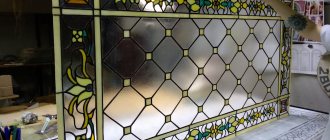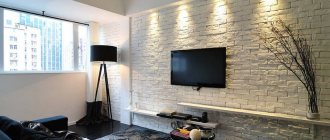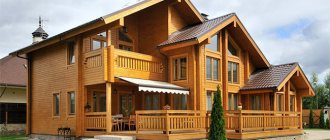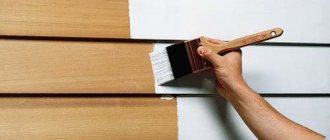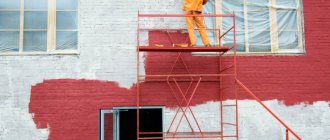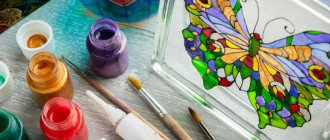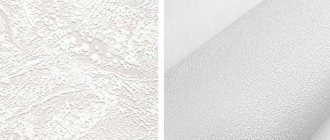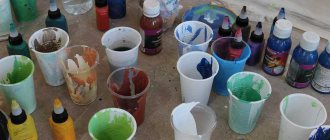Icer
21877 2 5
Icer November 28, 2016Specialization: master in the construction of plasterboard structures, finishing work and laying floor coverings. Installation of door and window units, finishing of facades, installation of electrical, plumbing and heating - I can give detailed advice on all types of work.
In the photo: in order for the decoration to be not only beautiful, but also reliable, you need to properly prepare the base
My wife has been decorating various products for a long time, and I am responsible for preparing the surfaces. Over several years, I have accumulated a lot of experience in priming various materials, which I want to share with you. I will tell you how to make a reliable and durable base for decoupage on different materials for a reasonable price.
The advantage of this decoration option is the ability to work on any type of surface, including metal and wood.
Plastic and glass are complex substrates that are important to prepare correctly
Stained glass
In addition to the richness of the range of colors, the material is distinguished by the choice of consistency, which will depend on the composition. The classification of this type is based on the main component:
- Water based . Opaque hypoallergenic paint, the action of which is similar to oil compositions. It has a number of disadvantages. The first is an insufficiently saturated palette due to the lack of resins in the composition. The second is a short shelf life. Firing is required for fixation. For uniform application, you must have experience working with this type of material.
- Alcohol paint . It is characterized by increased resistance to the external environment. It is characterized by brightness, saturation and brilliance. A brush is used for application, and special solvents are used for removal. There is no need for firing.
- Varnish based . Has a characteristic smell. It hardens within a few days, without requiring additional procedures. Diluted with a special solvent.
Is it possible to paint tiles?
From time to time you want to update your interior, and the hardest thing is with coatings that are difficult to replace. These include tiles. And it would be necessary to change it, but when you remember the expenses, the dirt, and you don’t want anything anymore. Therefore, when you are tired of the old tiles, have not yet decided to lay a new one, but want to refresh the appearance, we begin to think about whether it is possible to paint the tiles. In principle, it is possible. But this is a temporary option. And, as a rule, it is not very durable. Everything looks decent from a few months to three to five years. The period until everything looks good depends on:
- Type of tiles. On a glazed surface, there is a high probability that the paint will begin to peel off quickly and peel off. If the surface of the tile is rough, then properly selected and applied tile paint will last for some time.
- Preparing the base. Smooth - glazed - tiles must be made rough. All the rest - wash well and degrease. There will certainly not be a normal result on a dirty or greasy surface.
Paint for ceramic tiles - a way to change its appearance without replacement - Selected materials. The choice of paint for tiles and primer must be approached carefully and thoughtfully. There are not so few materials and new ones are constantly appearing. Read the description carefully, even if you were told that this is what you need.
- Compliance with technology. Materials for painting tiles are produced by famous companies. In any case, we recommend buying these. They often post technological maps. They describe in detail where, when, how and in what order the work should be carried out. If you follow the recommendations, the result is guaranteed. And, it’s better to read the technology of the work before you buy it. Just believe me.
Let’s say right away that cheap paint for ceramic tiles is a fantasy. There is no such option. The price for materials is decent. Maybe just a small area will help you avoid spending too much.
Acrylic
Acrylic-based paint has a rich palette, and the shades are easily mixed with each other. Small areas can be painted with a brush, but it is more popular to use acrylic mixtures in an aerosol can format. To increase stability, it is not necessary to resort to firing - it is enough to apply acrylic varnish on top of the dried drawing and the product will not be subject to fading in the sun and temperature fluctuations.
Separately, it is worth highlighting acrylic polymers - this is a technology for painting with a special composition based on acrylic resin. Quick-drying coating that does not require additional processing. It is highly resistant to water, chemicals and other external factors. When working, it is not necessary to use special tools. The method makes it possible to coat workpieces of any shape and size. The image can be either a single color or a complex multi-component pattern.
Volumetric floor
A type of liquid glass waterproofing is a coating technology with a 3D effect. To obtain a three-dimensional image, apply 3 layers:
- base polymer layer;
- drawing or photograph made on banner fabric;
- final polymer layer 3-4 mm thick.
The volume of the image depends on the height of the last layer, but it is not recommended to apply it more than 4 mm. The service life of glass coating with 3D effect is more than 10 years. It is very durable and resistant to mechanical stress.
Ink, felt-tip pens, markers
There are special felt-tip pens for working with glass or ceramic surfaces. They are created in such a way that, if necessary, the applied image can be removed.
An ideally smooth canvas can be coated with a special ink that has high adhesive properties. With its help you can achieve clear lines. Application is done using a rapidograph. This tool distributes the mascara in such a way that a line of a certain thickness is obtained.
Acrylic based material
The most popular and popular is acrylic varnish. This varnish is made on a water or turpentine basis. The basis of acrylic varnish is a colorless resin, to which thickeners and stabilizers are added.
This type of varnish has a lot of advantages; we can say that it is a unique and universal means for covering various surfaces.
- In addition to the fact that it can be used as a final coat, the varnish can be mixed with acrylic paints or gouache to obtain a more saturated color and abrasion resistance of the material.
- When the varnish is completely dry, the surface of the product can be cleaned using water-based solutions. Acrylic varnish is widely used to coat glass and mirror surfaces, and when used as a paint, this varnish gives them an amazing glossy shine.
- The varnish is sold ready-made, that is, it is not required to be diluted with water or other liquids. If the varnish has not been used for a long time and has become very thick, then you can return it to its original consistency simply by adding a little water to it.
To dry acrylic varnish, air humidity of at least 50% is required; because of this feature of the varnish, it is problematic to use it in winter. The varnish is environmentally friendly and comes in several types: matte and glossy.
It also comes in satin—half matte. The varnish is available in liquid and aerosol form. When using the material, a synthetic brush or roller is required.
Cleaning
The fabric to be painted must be clean. If the glass is slightly dirty, just wipe it with a soft cloth or damp cotton pad. It is not recommended to use synthetic materials, because... If pressed hard, they can dull the surface.
If small and medium-sized glasses are heavily soiled, you can wash them in the bathroom:
- Place the cloth in the bath and clean it with a napkin, while pouring warm water from the shower over it.
- After cleaning, the glass is thoroughly wiped dry - if you leave the surface wet, streaks will appear on it after drying.
After this, it is necessary to immediately proceed to the next stage of work, since the friction of fabric materials on the surface of the glass charges the latter with static electricity. The electrified canvas attracts dust, which leaves micro-scratches on the glass and interferes with painting.
If the glass initially has small scratches, it is necessary to polish it using a special paste. If you don’t have one, you can use a homemade analogue. To make it, mix soda and toothpaste in a 1:2 ratio. The mixture is applied to the damaged area, after which the glass is polished in a circular motion using a polishing roller.
Preparing tiles for painting
From the very beginning you need to wash the base. The paint is applied in a thin layer and even small irregularities - drops of grease, lime stains - everything will be visible. Therefore, we wash and clean thoroughly. If you decide to paint the floor tiles in the bathroom, first remove all silicones, grout, level and clean the seams.
It all starts boringly - with cleaning
Further. If the tile is glazed, it is better to scratch the glaze. There are many ways.
- If you have a grinding machine, this will simplify the task. We use sandpaper with medium grain and make the surface rough.
- You can try a grinder with a grinding attachment. But it will be too dusty.
- Wire brush.
- A block wrapped in coarse or medium grit sandpaper. We select the grain experimentally.
After sanding, dust should be removed (with a vacuum cleaner). The following describes the processing.
Brushes, scrapers, abrasive and non-abrasive detergents - anything to keep the base clean
Some primers have such good “adhesion” that there is no need to sand a smooth surface (for example, Zinsser Bulls Eye). Then the base should be washed and degreased. For degreasing, you can use White Spirit 1050 or Pensselipesu detergent. Wait for it to dry.
Protection of unpainted areas
If the glass is partially painted or installed in a frame, you need to mask off the unpainted areas. The most affordable means is masking tape . A simple and practical option that eliminates paint contamination. Glued end to end with the frame. However, the tape has disadvantages:
- Big expense.
- Minimum experience required. Otherwise, the tape will wrinkle, resulting in wrinkles.
- Changes in properties at high air temperatures. Tape glued in a warm room will stick tightly. Removing the remaining pieces of masking tape is a long and difficult process. If this happens, it is recommended to soak the strips in dishwashing liquid.
You can remove the tape only after the glass has completely dried. Otherwise, the uniformity of the layer bordering the edge of the tape will be disrupted. This is especially true in multi-layer painting.
As an alternative to masking tape, you can use cloth or paper . The fabric strip is pre-wetted in soapy water and glued to the surface. Material that is too thin may allow paint to pass through if it is not lathered well. In the second option, clean white paper should be used. When using magazine sheets and newspapers, the image will be printed on the glass. Attaches with water. Unlike masking tape, you must remove the paper as you paint. Otherwise, it will peel off on its own and stick to the freshly painted glass.
To protect hard-to-reach areas, you can use thick oil or Vaseline. After application and drying, the paint is wiped off with a rag.
Conclusion
Coating glass wallpaper with paint is a fairly simple and quick procedure. The most important thing is to choose a suitable composition that will not change the properties of the finishing material. Otherwise, you just need to stick to technology.
For more information on this topic, watch the video in this article.
For design purposes, it is best to choose glass wallpaper as a finishing material. They not only have excellent external properties, but can also be easily painted, maintaining their texture.
Tools and operating procedure
The following products can be used for application:
- Flat brush.
- Hard brush.
- Spray gun.
- Paint roller.
- Foam swab.
The choice of tool is determined from the point of view of the painter's convenience and surface area. It is easier to paint small glasses with a brush, but it is impossible to paint a large canvas efficiently without a spray bottle.
Procedure:
- After preliminary preparation of the glass, you need to install it on a flat surface in a horizontal position. Otherwise, the likelihood of leaks increases. Painting in a vertical position is used only in the case of a spray gun.
- Apply the paint in an even transition without streaks. It is recommended to do at least two layers with intermediate drying. Because The material is transparent; with a single layer of painting, unpainted paint will certainly appear.
- Wait until the fresh coat dries. After this, the glass can be fired or placed in a rack to dry completely.
Fiberglass wallpaper in all its glory
Fiberglass wallpaper is a practical and original type of rolled wall covering. This coating is made from glass fibers, from which the fabrics are woven. The way in which the fabric was woven affects the formation of a particular pattern on the surface of the wallpaper. The starting components of fiberglass are quartz sand, clay, soda and limestone. All of these are natural and therefore environmentally friendly substances, which will please many caring parents.
Fiberglass wallpaper not only has an environmentally friendly composition, but also a number of advantages:
- The main advantage of glass wallpaper: they do not support combustion, do not emit toxic substances and are a deterrent to the spread of fire. This is possible thanks to their unique composition, which includes non-flammable components. This feature allows this material to be used even when finishing escape routes in case of fire.
- Fiberglass is a very durable material that can even be found in aircraft construction. This news will please pet owners. Claws and beaks cannot break through here, since the canvas can withstand tensile loads of up to three tons per 1 m2.
- Fiberglass wallpaper is very practical to use. Their service life is more than 30 years, and during this time they can be repainted up to 20 times, subjected to mechanical and chemical cleaning. They will also protect walls from the appearance of microcracks and other defects.
- Fiberglass does not accumulate static electricity, which means it does not attract or collect dust.
- The fabric structure of the wallpaper allows air and moisture to pass freely, thereby not creating conditions for the formation of mold and mildew.
- A wide range of textured designs is designed to satisfy the most capricious consumers.
This miracle material also has disadvantages. An undeniable disadvantage is the rather high cost, and since glass wallpaper must be painted, the amount of costs also increases by the price of paint materials.
If the advantages still outweigh the disadvantages, then when choosing wallpaper you need to keep in mind that they come in two main types: regular and jacquard. The usual ones have a simple type of weaving in the “rhombus”, “Christmas tree” format, etc. Jacquards have a complex and often asymmetrical pattern such as “bamboo” or “stained glass”. Glass wallpaper, regardless of type, is sold in rolls (the world standard is 1 m wide, 12.5 m, 25 m, 50 m long) with end caps that protect the edges from damage.
How to consolidate the result?
Depending on the type of paint, one of the proposed methods is used:
- Drying out . Mandatory conditions: room temperature not lower than 18 degrees and relative humidity in the range of 50-80%. The time for complete drying of glass ranges from 1 to 48 hours depending on the paint.
- Seal with varnish . The product is applied in 1-2 layers so that the surface does not become glossy. It is recommended to purchase paint and varnish from the same manufacturer.
- Firing . If it is necessary to fix heat-resistant paint, the glass is placed in a special oven. At home, you can get by with a kitchen stove oven. The painted canvas is laid out on the oven grate, after which the required temperature is set. All that remains is to note the time and wait for the product to cool completely.
Paint for ceramic tiles
The main question is how to paint tiles in the bathroom and kitchen. Ceramics are smooth and non-absorbent substrates, and there are many paints for such surfaces. They are not budget ones, but not all are very expensive. There are from the middle price range. Look at the characteristics so that it has high hiding power, strength, and the ability to wash, and with brushes. The surface can be glossy or matte. The degree of gloss and matte varies. This alone gives a sufficient number of options even in one color. You can also use templates, stickers and other methods.
Paint for ceramic tiles can be:
- superurethane enamel;
- epoxy paint;
How the bathtub changed after painting - alkyd paint;
- paint for ceramic tiles;
- glass paint;
- enamel based on chlorinated rubber;
- auto enamel.
When you decide to paint the tiles in the bathroom or kitchen, immediately look for a pair - a primer and paint. They must fit one another. Typically, paint manufacturers recommend specific primers. Look through the recommendations, you may find what you need and you won’t have to think about the compatibility of the ingredients.
Scope of application of painted glass
Product color changes may be required in the following areas and products:
- Wall cladding is a plain or contrasting fabric.
- Furniture production - in the decoration of cabinets, shelves, tables.
- Decoration of entertainment facilities - glass partition, bar area.
- Shopping center showcases and partitions for dividing commercial spaces.
- In living quarters - decorating functional elements in kitchen and bathroom interiors.
- Functionally decorative partition. Used for fencing stairs or elevator cabins.
